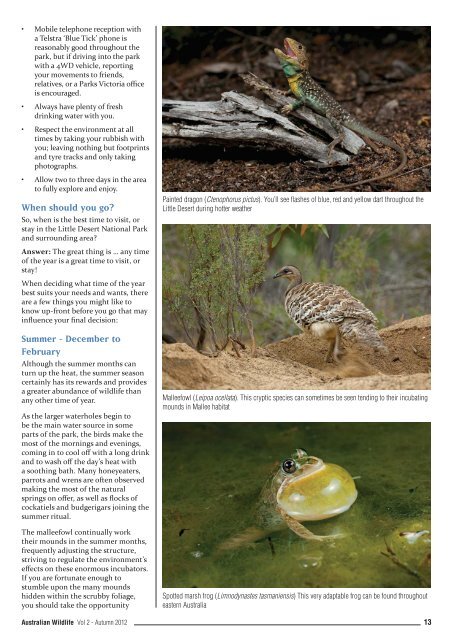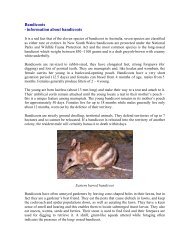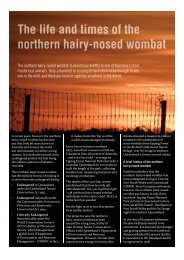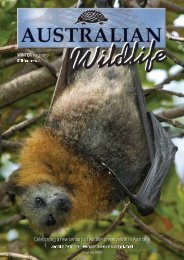Wildlife Preservation Autumn 2012.indd - Wildlife Protection Society ...
Wildlife Preservation Autumn 2012.indd - Wildlife Protection Society ...
Wildlife Preservation Autumn 2012.indd - Wildlife Protection Society ...
Create successful ePaper yourself
Turn your PDF publications into a flip-book with our unique Google optimized e-Paper software.
• Mobile telephone reception with<br />
a Telstra ‘Blue Tick’ phone is<br />
reasonably good throughout the<br />
park, but if driving into the park<br />
with a 4WD vehicle, reporting<br />
your movements to friends,<br />
relatives, or a Parks Victoria o ce<br />
is encouraged.<br />
• Always have plenty of fresh<br />
drinking water with you.<br />
• Respect the environment at all<br />
times by taking your rubbish with<br />
you; leaving nothing but footprints<br />
and tyre tracks and only taking<br />
photographs.<br />
• Allow two to three days in the area<br />
to fully explore and enjoy.<br />
When should you go?<br />
So, when is the best time to visit, or<br />
stay in the Little Desert National Park<br />
and surrounding area?<br />
Answer: The great thing is … any time<br />
of the year is a great time to visit, or<br />
stay!<br />
When deciding what time of the year<br />
best suits your needs and wants, there<br />
are a few things you might like to<br />
know up-front before you go that may<br />
in uence your nal decision:<br />
Summer - December to<br />
February<br />
Although the summer months can<br />
turn up the heat, the summer season<br />
certainly has its rewards and provides<br />
a greater abundance of wildlife than<br />
any other time of year.<br />
As the larger waterholes begin to<br />
be the main water source in some<br />
parts of the park, the birds make the<br />
most of the mornings and evenings,<br />
coming in to cool o with a long drink<br />
and to wash o the day’s heat with<br />
a soothing bath. Many honeyeaters,<br />
parrots and wrens are often observed<br />
making the most of the natural<br />
springs on o er, as well as ocks of<br />
cockatiels and budgerigars joining the<br />
summer ritual.<br />
The malleefowl continually work<br />
their mounds in the summer months,<br />
frequently adjusting the structure,<br />
striving to regulate the environment’s<br />
e ects on these enormous incubators.<br />
If you are fortunate enough to<br />
stumble upon the many mounds<br />
hidden within the scrubby foliage,<br />
you should take the opportunity<br />
Australian <strong>Wildlife</strong> Vol 2 - <strong>Autumn</strong> 2012<br />
Painted dragon (Ctenophorus pictus). You’ll see flashes of blue, red and yellow dart throughout the<br />
Little Desert during hotter weather<br />
Malleefowl (Leipoa ocellata). This cryptic species can sometimes be seen tending to their incubating<br />
mounds in Mallee habitat<br />
Spotted marsh frog (Limnodynastes tasmaniensis) This very adaptable frog can be found throughout<br />
eastern Australia<br />
13





